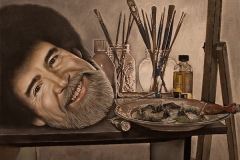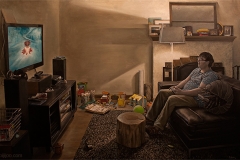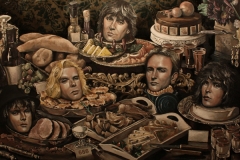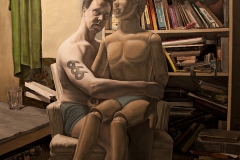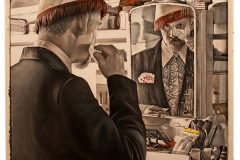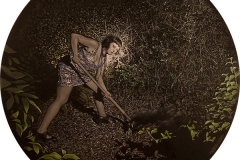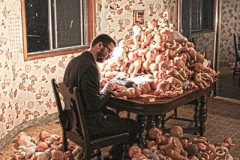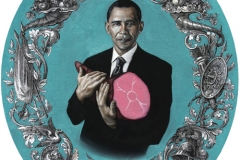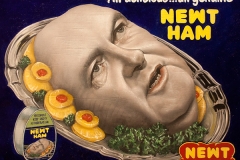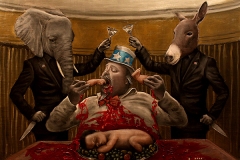An Interview with Bijijoo
 by Benjamin Davis Brockman
by Benjamin Davis Brockman
December 1, 2012
It might surprise anyone looking at the work of Portland-based bijijoo to learn that his training is in not in painting, but Biophysics. After years of studying math and earning a PhD in chemistry in 2008, he picked up a brush and has been extremely prolific ever since. Operating under an assumed name, bijijoo has created an oeuvre that is expansive in its themes and rich with flippant irony. His body of work is comprised in large part by ambitious series like The Presidential Ham, in which each of the 44 U.S. Presidents are depicted holding, yes, ham. Why a ham? Well, why the fuck not? Bijijoo cites a friend’s obsession with lard as a possible impetus for the first appearance of the ham, as well as that friend’s impulse to leave large chunks of lard in the homes of unsuspecting friends. Hence the advent of “larding.” This might be the most telling bit of information one can know when accessing bijijoo’s work; to ask “why a ham?” would be missing the point. This is the playfulness and charm of bijijoo.
He admits his distaste for academia, so it stands to reason that academic discussions of his work aren’t really of interest to him. The true irony of bijijoo is that if there is any formal academic conversation about his work to be had, it’s in his rigid, technical style. bijijoo’s recent work is so technically acute that if the subject matter were just still lives, less the cleverinsertion of celebrity heads, or just portraits of friends, less the Anthropod Companions, the work could fit neatly on the mahogany shelves of an affluent law office or among the pages of some hobbyist review.
The eerie gravity in bijijoo’s work may come from this strange marriage of style and content. It is at once sardonic and beautiful. His paintings read as pensive assessments of global focal points against the backdrop of intimate surroundings. While he cites Hans Holblein the Younger and works from the Quattrocentro as chief artistic interests (proving the he has done more homework than a number of young working artists I know), his expansive catalog could just as easily owe a debt to the pages of MAD Magazine.
It is refreshing to hear an artist discuss what he does in terms of his personal drive or his need for satisfaction. That is the right answer to why any artist does what he does. Ultimately, bijijoo see’s each project he embarks on as practice, a step in the grander mission mastering his chosen medium. While the content certainly comes second to that, the marriage of his dedication to craft to a clever orneriness make bijijoo’s work very slick indeed. I wanted to pick his brain, and he graciously obliged.
The Fiddleback: The vast majority of your work is in oil paint. Do you have feelings about this medium, in particular, as it relates to the content of your work?
bijijoo: I prefer oil paint to acrylic. Oil paint provides a lot of depth through layering that can’t be achieved as well in acrylic. The medium doesn’t really relate to the content of the work. It’s kind of the other way around, where the content gives me an excuse to continue practicing painting in order to improve technique and execution. I think oil paint is the most versatile given its drying time and layering possibilities. I generally strive towards very technical painting execution. I feel like I have a long way to go towards improvement, at least 5-10 years. The content gives me motivation in the sense that, even if the technique is not as good as I might like, at least it is a painting that interests me.
The Fiddleback: There is a very clear trajectory of growth from your early work to the work you are doing now, both technically and thematically. How has your creative practice changed over the years?
bijijoo: I’ve been making art things since childhood and have spent a lot of time working on various different types of art projects: music, abstract drawing/painting, photocopy machine art, writing, photography, video, etc. Very scattered. Then I got really into math and science for about 10 years. I started painting again after finishing a PhD in chemistry in 2008. At that time, I was just trying to make ridiculous paintings that someone might stumble upon someday in a thrift store or in a pile of garbage. For example, a huge horrible painting of Saddam Hussein holding an apple pie, currently displayed in a friend’s party room in his basement, would be a great thing for someone to come across at the dump 20 years from now. However, the more I started painting the more committed to it I became. Now, perhaps unfortunately, I’m trying to actually get good at it.
The Fiddleback: What is the story of the Krampus emblem? How does this embody the spirit of what bijijoo does?
bijijoo: The idea of Satan comforts me and represents a very particular thing to me, which drives a lot of the work I do. I like Krampus because he’s a familiar creature that will fuck with you but won’t destroy you. The emblem is a linocut I made based on an antique toy version of Krampus. I like to think that I’m not afraid of making a painting of anything, including horrible things or perhaps uncomfortable things.
I was just trying to make ridiculous paintings that someone might stumble upon someday in a thrift store or in a pile of garbage. For example, a huge horrible painting of Saddam Hussein holding an apple pie would be a great thing for someone to come across at the dump 20 years from now.
The Fiddleback: Can you give a little background on the NBC copyright spat? It appears as though it started as an ironic gesture, which took on a life of its own and became its own project. Does that typify any sort of agenda that you maintain elsewhere in your body of work?
bijijoo: I work at an intellectual property law firm. I’m not a lawyer but rather a scientist employed by the firm to do research. At the time I was working on that, which was a little while back, I was using it as a way to try to bring my experience at the law firm into an art project. Additionally, I used it as an excuse to learn more about copyright issues, something I am very interested in. I was aiming for a slightly surrealist bent, where serious letters are exchanged discussing the shapes of hams and how they are held.
The Fiddleback: Can you describe the genesis of the ham motif? Which came first: The Presidential Ham or Hamtopia?
bijijoo: A big ugly painting of Richard Nixon holding a ham came first. Friends and I used to visit people’s home in the middle of the night and leave a big chunk of lard on their front porch for fun, as in, “We went Larding last night” or “David got hella Larded last night.” This naturally led to ham veneration. After a few bad paintings of people holding hams (e.g., Nixon, Reagan, Bush, Clinton, and Kevin Federline) I made a New Year’s resolution to paint every single president holding a ham. My main motivation was to practice painting. I still have the papier-mâché cornucopia I used as a model for the hams that appear in the paintings. It’s more like a shofar than a pork product. Hamtopia just kinda fell out of that.
The Fiddleback: Your series The Chamber of Scientists gives iconological treatment to prominent figures in the history of science. There is sort of an interesting correlation here between political figures, scientists, and pop culture icons throughout your body of work. In The Celebrity Still Life series in particular, the subjects are imparted less with a reverence of stature and more with the fleeting novelty of a Chia Pet. What is important to you in addressing the subjects you choose?
bijijoo: Unfortunately, the chamber of scientists series has been on hold for a little bit while I rethink my approach. Mainly, I’m sorting out the best way to execute the series (e.g., as portrait miniatures?). I have connections (read: librarian friends) to a lot of historical archives with photographs of great scientists and doctors, and I would like to continue highlighting lesser-known scientists who have made significant and interesting contributions.
Regarding the celebrity still life series, I’m really into still life paintings, and celebrity culture fascinates and horrifies me. Still life paintings need some sort of focal point, and sticking a celebrity head in them gives the viewer something to latch onto. I’d like to be able to make celebrity still life paintings that transcend the celebrity and stand alone as something beautiful. See, for example, Sherrie Wolf’s still life paintings.
The Fiddleback: Do you have a destination in mind as you create your work? Does your audience include the internet, the gallery or some other demographic? Has the internet or social media affected what you do as an artist?
bijijoo: Of course, the internet has been great for reaching a larger audience more easily, and the direction of some projects are sometimes influenced by the reaction I perceive over the internet. Some paintings are pretty much made for the internet (e.g., I can’t imagine anyone wanting to hang some of these paintings in their homes). That said, I like having a physical object, which I labored for hours and hours over, behind the digital image that is displayed on the computer. Since these are layered oil paintings, though most of them translate well to digital media, they have a depth when viewed in person that can’t be captured via a photograph. Some of the work is currently moving more toward a gallery audience (e.g., larger, more detailed paintings). I am also strategizing on how to incorporate the bug paintings into a book—I’m working with some writers and designers at the moment to see where that could go.
The Fiddleback: What do you see as being the role of the artist in society? By nature, your work contains a societal critique in its humor and the preciousness of its formal elements. Why is what you do important or different?
bijijoo: This is a loaded question—I don’t really think that anything has much of a point, and I certainly don’t or can’t think that anything I do is important. I’m just trying to get really good at doing one thing. I like making things and pushing myself, having something to think about and plan out and then execute is satisfying to me.
It seems like a lot of artists, particularly based on their artist’s statements, come across as assigning too much importance to the work they do and sound too self-important. For me, doing the painting work is a very personal matter—if I wasn’t always pecking away at a project or pushing myself in some way, I would get depressed. It’s just something I use to inject some sort of meaning and drive into my living. On the other hand, as an art consumer, I regard art as very important—I love that something so simple as a single image can evoke all sorts of different reactions. As a viewer, I also use art as inspiration and to drive myself to get better, to learn new techniques, etc.
The Fiddleback: What role does art play in your life outside of the studio? Where do you find inspiration?
bijijoo: I tend to not like discussing the artwork I do with anyone ever—I think this relates to it being a very personal matter and my not wanting to have to explain myself. Also, it has to do with feeling like I’m not very good at it, which may sound negative, but I think this view drives me to constantly push myself to get better. As I remarked before, I view this as practice.
I find inspiration all over the place, from Tiger Beat magazines, old catalogs, my science and math training, the patent writing I do as a job, and other people’s art work.
Some people seem to feel relieved when they find out I don’t make a living doing art because if I did make a living doing it, it would challenge some sort of preconceived notion they have about art being less important or whatever—perhaps not being legit. I don’t know.
The Fiddleback: It’s really interesting to me that you came back to art after studying math and science for so long. Do you see any relationship or overlap between those interests? In terms of your approach to creating work, does your background inform your process? Or vice versa?
bijijoo: I spent a lot of time trying to bring math together with art and music in a technical sense. There are a lot of monographs exploring such combinations, but most of them are pseudoscience. As I remarked above, I draw inspiration for ideas from some of the science training, and I approach painting in a very technical manner, experimenting with techniques, trial and error, understanding optical properties of light, etc. So, in some ways, my approach to painting is informed by my science training, but in a superficial way. I don’t really think they are related.
The Fiddleback: Do you have formal or academic training in painting? I ask because, if not: DAMN—and if so, still DAMN.
bijijoo: I don’t really have any formal training. I took a painting class when I was 10 years old or so and a portrait painting class as a teenager. Beyond that, I have just studied various books and old artwork (Renaissance painters, e.g., Hans Holbein the Younger). I have mainly improved through a commitment to practice and through developing specific techniques through trial and error.
The Fiddleback: I read that biji was a name given to you by a friend through a story he wrote. Any clues on what this story was? Does the name signify anything particular to you?
bijijoo: That story is uninteresting. I just like the letter B (and I go by that name) and the name biji. The name bijijoo came about when I was picking a domain name about 10-12 years ago. It doesn’t have any particular meaning.
——–
bijijoo
